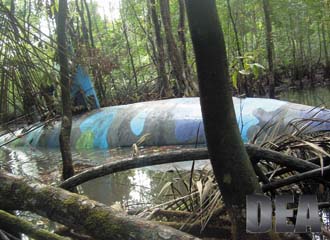Intelligence Key to Counterdrug Efforts
 |
U.S. Drug Enforcement Administration (DEA) agents, working with Ecuadorean military and law enforcement organizations, recently discovered a fully operational diesel-electric submarine capable of carrying several tons of cocaine. Featuring a periscope-equipped conning tower and air conditioning, the submarine was built in a remote part of the jungle near a river tributary to which it would have been portaged for eventual sea access. The twin-screw craft is 100 feet long and tops out at nine feet in height internally, and it could be used to smuggle terrorists and their weapons as well as narcotics. |
The transnational threats of drug trafficking, money laundering and narcoterrorism have increased the value of international intelligence to the U.S. Drug Enforcement Administration. The agency is interoperating more closely with
Not all this interoperability comes smoothly, however. The Justice Department agency must adhere to intelligence gathering and dissemination laws strictly. It also must ensure that its use of vital intelligence does not compromise sources or methods. And, its overseas cooperation must follow laws and regulations of at least two countries—the
Anthony Placido, assistant administrator and chief of intelligence for the Drug Enforcement Administration (DEA), points out that transnational drug activities usually are based in foreign countries where the perpetrators believe they are safe from
The nature of the DEA’s work always has involved intelligence in some form or another, Placido points out. This intelligence may come from the streets of
The DEA’s involvement in the
“The same shadow facilitators—the people who are document forgers, money launderers and transporters—are overlapping in the terrorism and narcotics world,” he says.
Returning to the intelligence fold has allowed the DEA to make better use of community assets and tools in its investigations, Placido says. The agency can obtain products such as situational awareness, imagery and output from other national technical means that can be used as tips and leads to point the DEA in the right direction. The agency then can operate along its own lines of methodology to reconstruct that information in a manner that can be introduced into court.
Many of the agency’s transnational threats involve hybrid organizations that are “one part transnational criminal organization and one part terrorist,” he states. Among these are the Revolutionary Armed Forces of Colombia, or FARC; Lebanon-based Hezbollah, which has a presence in the Western Hemisphere;
Being a component in the post-9/11
The result was that in 2006 the DEA created its own hybrid organization that includes a sliver of the agency’s intelligence program. Funded under Title 50 of the U.S. Code—which covers war and national defense—and through the National Intelligence Program, this Office of National Security Intelligence serves as the facilitator for the DEA to issue requests to the intelligence community. It also allows the DEA to push information to the community while preserving the primacy of the law enforcement mission for the full DEA.
The office includes representatives from intelligence community agencies,
Placido emphasizes that no one who exercises law enforcement authority serves in this office. He describes it as purely an analytic and liaison function within the DEA. Information is gathered and evaluated by this unit, which then pushes it to the community. However, a strict firewall around it prevents any other intelligence organization—even the Office of the Director of National Intelligence—from reaching through the DEA group and exercising law enforcement authorities. This serves to meet many civil liberty concerns and limitations, he adds.
“We’re not going to be engaged in working counterespionage or counterterrorism cases unless there is a nexus to drug trafficking,” Placido states. “That was helpful with our foreign counterparts … in that we really are a distinct organization that still works counternarcotics. And, it solves the bigger problem of allowing us to continue to conduct investigations without regard to problems with
Unlike conventional intelligence operations where the goal is to ensure the continuity of the information flow, DEA’s approach is to treat the information as just a means to an end—prosecution and conviction in a
Yet technology plays an important role in DEA intelligence gathering. Placido offers that the agency runs more Title III electronic communications intercepts than any other
 |
Nearly $1 million in cash is part of a DEA haul from a series of nationwide drug raids earlier this year. DEA intelligence officers are seeing a greater confluence between drug smuggling and terrorism, as the narcotics trade offers an easy source of badly needed funds for terrorists. |
The DEA also leads the
The tools used in DEA information processing largely focus on consolidation and coordination. Automatic deconfliction tools help make connections between disparate bits of information, such as telephone numbers, e-mail addresses, bank account numbers, physical addresses and license plate numbers. These deconfliction tools have been expanded outside the federal government through the DEA Internet Connectivity Endeavor, or DICE, program. This allows state and local governments to load their own information and deconflict it among themselves and determine if the federal government has the same or similar information.
In the field, the agency has deployed a line of license plate readers a few miles north of the southern
Processing power and bandwidth are the two biggest advantages the federal government has over transnational criminal organizations, Placido declares. The ability to process large amounts of information and move it around the world to be shared among investigators keeps law enforcement in the game against its criminal adversaries.
The technology challenges that remain are collection and sharing policy issues, he offers. Persistent surveillance and precision geolocation are at the top of the DEA’s technology wish list. “If we could be omnipresent and know of the existence of many of these targets over time and then precision-geolocate them, then all that’s left is getting willing partners that can do something about them in the physical space—which is a relatively easy problem,” Placido warrants.
All these efforts are necessary because the threat of narcoterrorism is “very real and growing,” Placido says. He cites a preponderance of evidence and a consensus within the intelligence community that terrorist organizations increasingly are seeking alternative sources of revenue as state sponsorships have dried up. The intelligence community and security services also have drained the well of charitable front organizations. “Many more of these [terrorist] organizations are forced to sing for their own supper,” he relates.
Placido cites United Nations (U.N.) estimates that the global illicit drug trade generates $394 billion annually. That amount is more than the annual budgets of 90 percent of the nations on Earth. Among criminal endeavors, that amount is 10 times the total of the next-highest illegal revenue, that of human trafficking. “We see that huge source of [drug] revenue being used by a variety of traditional terrorist organizations,” he reports. “Unfortunately, it is a trend that we see growing into the future.”
The organization that is “most deeply embedded” in narcoterrorism is FARC, Placido states. Describing FARC as a model for where narcoterrorism is going, he points out that FARC began as an ideologically motivated organization with the political goal of overthrowing the government of
However, that degeneration has exposed FARC for what it really is, Placido declares, and a broader set of tools can be brought to bear against the group. He describes FARC’s status as “the most blatant case of narcoterrorism anywhere on the planet.”
Other terrorist groups have joined the narcoterrorism world. The Taliban in
Placido notes that of the 44 organizations designated by the U.S. State Department as terrorist groups, 18 are engaged in at least some aspect of the drug trade. The March 11, 2004,
Concern is growing about linkages between
WEB RESOURCE
Drug Enforcement Administration: www.justice.gov/dea
DEA Outreach Seeks to Forestall Local Problems The Drug Enforcement Administration is applying actionable intelligence to local counterdrug efforts through a special outreach program. In this effort, citizen leaders go to school in a program that educates community leaders in the key issues that affect antidrug operations. This outreach effort differs from that of the intelligence community in that the intelligence program sought to show citizens how they could contribute information that might help forestall a homeland terrorist attack (SIGNAL Magazine, October 2009). The Drug Enforcement Administration (DEA) effort aims at empowering citizens to help recognize and prevent problems in the community before they become law enforcement issues. The outreach program focuses on two elements: the nature of the threat, and DEA’s efforts to combat it. Participants learn details on a global scale and in local terms. And, they are given a better understanding of DEA’s mission and how it carries it out. The outreach program focuses on two elements: the nature of the threat, and DEA’s efforts to combat it. Participants learn details on a global scale and in local terms. And, they are given a better understanding of DEA’s mission and how it carries it out. Ava Cooper-Davis is special agent in charge for DEA’s “By reaching out to individuals, it is more personable,” she states. “It pays tremendous dividends.” A total of 27 people attended the first One point emphasized in the academy is the long reach of the drug threat. Cooper-Davis notes that many attendees are surprised to learn the extent of influence waged by foreign drug organizations such as those from The DEA’s Cooper-Davis offers that the “The [attendees] need to understand the threat and have a good sense of what they’re facing to have a true appreciation of what we do in our investigative efforts,” Cooper-Davis maintains. “This was a bright group of individuals—very progressive.” Building the class required its own outreach effort, and this included tapping diverse groups for representatives. Cooper-Davis relates that, for some participants, she reached out to local chiefs of police for recommendations. The DEA will continue to keep the participants engaged. This will include quarterly meetings and other agency activities, in addition to networking by the attendees. By establishing a continued, long-lasting relationship with these participants, the DEA hopes to keep open access to their communities and provide the seeds of drug prevention. Cooper-Davis offers that only a multifaceted approach can reduce drug abuse. “We can’t arrest our way out of the drug problem,” she points out. |


Comments